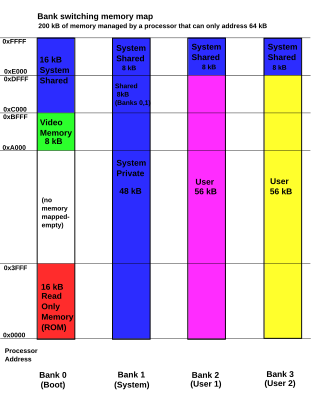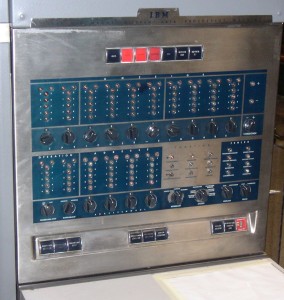A complex instruction set computer is a computer architecture in which single instructions can execute several low-level operations or are capable of multi-step operations or addressing modes within single instructions. The term was retroactively coined in contrast to reduced instruction set computer (RISC) and has therefore become something of an umbrella term for everything that is not RISC, where the typical differentiating characteristic is that most RISC designs use uniform instruction length for almost all instructions, and employ strictly separate load and store instructions.

A microprocessor is a computer processor for which the data processing logic and control is included on a single integrated circuit (IC), or a small number of ICs. The microprocessor contains the arithmetic, logic, and control circuitry required to perform the functions of a computer's central processing unit (CPU). The IC is capable of interpreting and executing program instructions and performing arithmetic operations. The microprocessor is a multipurpose, clock-driven, register-based, digital integrated circuit that accepts binary data as input, processes it according to instructions stored in its memory, and provides results as output. Microprocessors contain both combinational logic and sequential digital logic, and operate on numbers and symbols represented in the binary number system.

The Motorola 68000 is a 16/32-bit complex instruction set computer (CISC) microprocessor, introduced in 1979 by Motorola Semiconductor Products Sector.

The MOS Technology 6502 is an 8-bit microprocessor that was designed by a small team led by Chuck Peddle for MOS Technology. The design team had formerly worked at Motorola on the Motorola 6800 project; the 6502 is essentially a simplified, less expensive and faster version of that design.

The Motorola 6809 ("sixty-eight-oh-nine") is an 8-bit microprocessor with some 16-bit features. It was designed by Motorola's Terry Ritter and Joel Boney and introduced in 1978. Although source compatible with the earlier Motorola 6800, the 6809 offered significant improvements over it and 8-bit contemporaries like the MOS Technology 6502, including a hardware multiplication instruction, 16-bit arithmetic, system and user stack registers allowing re-entrant code, improved interrupts, position-independent code and an orthogonal instruction set architecture with a comprehensive set of addressing modes.

The Z80 is an 8-bit microprocessor introduced by Zilog as the startup company's first product. The Z80 was conceived by Federico Faggin in late 1974 and developed by him and his 11 employees starting in early 1975. The first working samples were delivered in March 1976, and it was officially introduced on the market in July 1976. With the revenue from the Z80, the company built its own chip factories and grew to over a thousand employees over the following two years.
In computer architecture, 8-bit integers or other data units are those that are 8 bits wide. Also, 8-bit central processing unit (CPU) and arithmetic logic unit (ALU) architectures are those that are based on registers or data buses of that size. Memory addresses for 8-bit CPUs are generally larger than 8-bit, usually 16-bit. 8-bit microcomputers are microcomputers that use 8-bit microprocessors.
The Motorola 68000 series is a family of 32-bit complex instruction set computer (CISC) microprocessors. During the 1980s and early 1990s, they were popular in personal computers and workstations and were the primary competitors of Intel's x86 microprocessors. They were best known as the processors used in the early Apple Macintosh, the Sharp X68000, the Commodore Amiga, the Sinclair QL, the Atari ST and Falcon, the Atari Jaguar, the Sega Genesis and Sega CD, the Philips CD-i, the Capcom System I (Arcade), the AT&T UNIX PC, the Tandy Model 16/16B/6000, the Sun Microsystems Sun-1, Sun-2 and Sun-3, the NeXT Computer, NeXTcube, NeXTstation, and NeXTcube Turbo, early Silicon Graphics IRIS workstations, the Aesthedes, computers from MASSCOMP, the Texas Instruments TI-89/TI-92 calculators, the Palm Pilot, the Control Data Corporation CDCNET Device Interface, the VTech Precomputer Unlimited and the Space Shuttle. Although no modern desktop computers are based on processors in the 680x0 series, derivative processors are still widely used in embedded systems.

Bank switching is a technique used in computer design to increase the amount of usable memory beyond the amount directly addressable by the processor instructions. It can be used to configure a system differently at different times; for example, a ROM required to start a system from diskette could be switched out when no longer needed. In video game systems, bank switching allowed larger games to be developed for play on existing consoles.

An index register in a computer's CPU is a processor register used for pointing to operand addresses during the run of a program. It is useful for stepping through strings and arrays. It can also be used for holding loop iterations and counters. In some architectures it is used for read/writing blocks of memory. Depending on the architecture it may be a dedicated index register or a general-purpose register. Some instruction sets allow more than one index register to be used; in that case additional instruction fields may specify which index registers to use.
4-bit computing is the use of computer architectures in which integers and other data units are 4 bits wide. 4-bit central processing unit (CPU) and arithmetic logic unit (ALU) architectures are those that are based on registers or data buses of that size. A group of four bits is also called a nibble and has 24 = 16 possible values.

In computer architecture, 36-bit integers, memory addresses, or other data units are those that are 36 bits wide. Also, 36-bit central processing unit (CPU) and arithmetic logic unit (ALU) architectures are those that are based on registers, address buses, or data buses of that size. 36-bit computers were popular in the early mainframe computer era from the 1950s through the early 1970s.
In computer architecture, 128-bit integers, memory addresses, or other data units are those that are 128 bits wide. Also, 128-bit central processing unit (CPU) and arithmetic logic unit (ALU) architectures are those that are based on registers, address buses, or data buses of that size.
Bit slicing is a technique for constructing a processor from modules of processors of smaller bit width, for the purpose of increasing the word length; in theory to make an arbitrary n-bit central processing unit (CPU). Each of these component modules processes one bit field or "slice" of an operand. The grouped processing components would then have the capability to process the chosen full word-length of a given software design.

Am2900 is a family of integrated circuits (ICs) created in 1975 by Advanced Micro Devices (AMD). They were constructed with bipolar devices, in a bit-slice topology, and were designed to be used as modular components each representing a different aspect of a computer control unit (CCU). By using the bit slicing technique, the Am2900 family was able to implement a CCU with data, addresses, and instructions to be any multiple of 4 bits by multiplying the number of ICs. One major problem with this modular technique was that it required a larger number of ICs to implement what could be done on a single CPU IC. The Am2901 chip included an arithmetic logic unit (ALU) and 16 4-bit processor register slices, and was the "core" of the series. It could count using 4 bits and implement binary operations as well as various bit-shifting operations. The Am2909 was a 4-bit-slice address sequencer that could generate 4-bit addresses on a single chip, and by using n of them, it was able to generate 4n-bit addresses. It had a stack that could store a microprogram counter up to 4 nest levels, as well as a stack pointer.

The history of general-purpose CPUs is a continuation of the earlier history of computing hardware.
In computer architecture, 12-bit integers, memory addresses, or other data units are those that are 12 bits wide. Also, 12-bit central processing unit (CPU) and arithmetic logic unit (ALU) architectures are those that are based on registers, address buses, or data buses of that size.

A decimal computer is a computer that can represent numbers and addresses in decimal and that provides instructions to operate on those numbers and addresses directly in decimal, without conversion to a pure binary representation. Some also had a variable wordlength, which enabled operations on numbers with a large number of digits.
In computer architecture, 16-bit integers, memory addresses, or other data units are those that are 16 bits wide. Also, 16-bit central processing unit (CPU) and arithmetic logic unit (ALU) architectures are those that are based on registers, address buses, or data buses of that size. 16-bit microcomputers are microcomputers that use 16-bit microprocessors.










